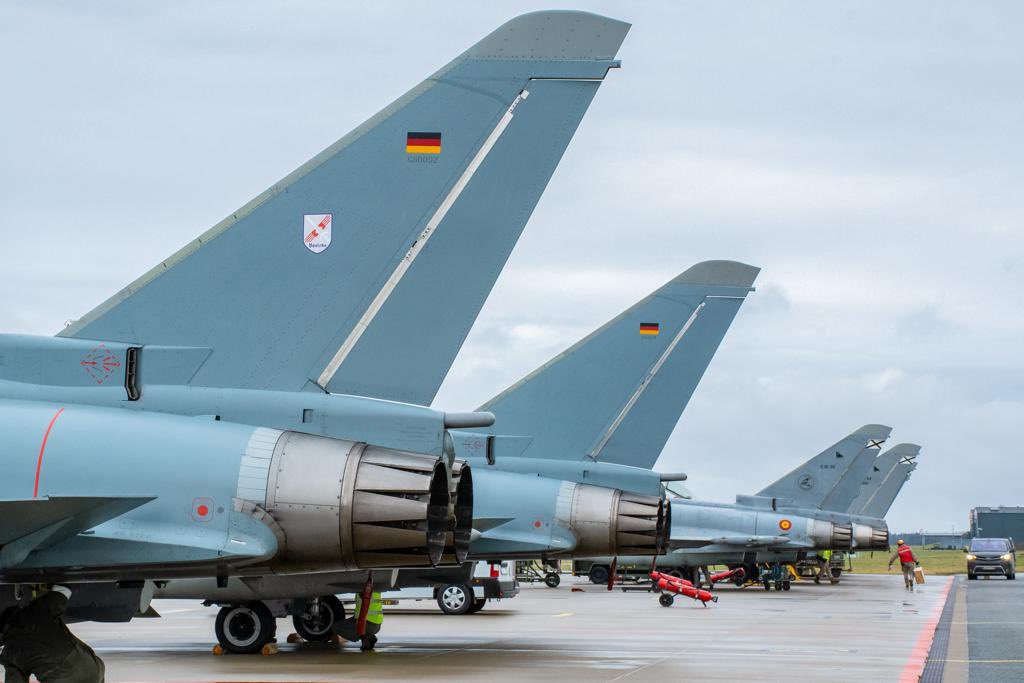The German Air Force, known as Luftwaffe, is exploring the feasibility of employing its Eurofighter Typhoon fighter jets from civilian airports to bolster the defense of major German cities.
Notorious For Popping-Up Near US Shores, Russian Navy To Acquire 3 More ‘Very, Very Advanced’ Yasen-Class Nuke Subs
On November 21, the German Air Force disclosed plans to conduct a city defense exercise called “Hannover Shield” in the upcoming week, aiming to simulate emergency scenarios.
In a press release, the Air Force disclosed that three Eurofighters from Wittmund will be temporarily based at Hannover Airport.
Frank Gräfe, the head of the department in the command of the Berlin Air Force, explained that the decision to train over the North Sea rather than the state capital allows the planes to operate at lower altitudes.
The primary objective of the exercise is to safeguard the population from aerial threats, enabling the swift detection and interception of potential dangers such as drones or cruise missiles.
Hannover Shield 23! Wir bereiten uns darauf vor, im Ernstfall deutsche Großstädte besser schützen zu können: Ab dem 27.11. werden vorübergehend drei Eurofighter aus Wittmund auf dem @HannoverAirport stationiert – eine Premiere. Die Jets starten täglich zu Trainingsflügen in… pic.twitter.com/OCNSHXybh4
— Team Luftwaffe (@Team_Luftwaffe) November 21, 2023
In the event of a genuine crisis, Gräfe stressed that the Air Force could be mobilized within a few hours to ensure the rapid response necessary for protecting against airborne threats.
This maneuver marks the first instance of utilizing an entire civilian airport infrastructure for an extended Air Force training exercise.
The comprehensive exercise involves leveraging the airport’s facilities, including power supply, electronics, equipment like forklifts, and accommodations for flight crews, airport staff, and firefighters.
Gräfe clarified that this preparation extends to ground personnel, firefighters, and air traffic control, ensuring readiness for potential emergencies.
Meanwhile, the service said Hanover Airport was selected for the exercise due to its suitability as an alternative airport for the Air Force at any given time.
One of the key factors is its continuous operation, functioning 24/7 throughout the year. However, the exercise is scheduled exclusively during daylight hours.
Military aircraft, as a standard procedure, require contingency airfields in case landing at the intended destination is unfeasible, possibly due to adverse weather conditions.
This shift towards civilian airports as alternatives is attributed to the evolving landscape, with fewer military airports now available for such purposes.
Fighter Jets At Civilian Airports
Many air forces globally view exercises involving fighter jets operating from civilian airports as crucial preparations for potential future conflict scenarios.
Japan, in particular, is intensifying its military training for such operations, driven by concerns about the possible Chinese invasion of Taiwan. Tokyo has reportedly identified 33 airports and ports across 10 prefectures for potential expansion.
Analysts argue that military air bases are likely to be primary targets in conflicts, prompting the exploration of dual-use scenarios involving civilian airports. Nonetheless, the use of civilian airports for military purposes during wartime or emergencies is not a new tactic and has historical precedents.
One notable case involved the Los Angeles International Airport (LAX), which was called Mines Field during World War II. During the war, Mines Field (LAX) underwent a conversion into a military airfield.

The US military stationed fighter aircraft there to defend the West Coast against potential air attacks by enemy forces. This adaptation enabled the military to utilize pre-existing infrastructure and facilities for their wartime requirements.
Likewise, during the Cold War era, Miami International Airport (MIA) served as a hub for a range of clandestine operations conducted by the CIA. The CIA operated the airline Southern Air Transport (SAT), based at MIA. This airline played a role in various Cold War activities, including supplying aid to the ‘Contras’ in Nicaragua.
EurAsian Times sought an expert’s opinion to understand whether, in the event of a conflict, commercial airports utilized for military purposes could be deemed a legitimate target.
Philippines-based military analyst Miguel Miranda said, “Of course they are.” He referred to Israel’s frequent attack on Syria’s Damascus airport, where Israel believes the transportation of advanced weaponry from Iran to its different Middle East proxies, particularly Hezbollah, occurs.
Nonetheless, the increased attention to these operations is driven by the fact that China and Russia have, over time, advanced their capabilities in long-range precision fires, encompassing numerous ballistic and cruise missiles.
This presents a serious test for the technological capabilities of contemporary air defense systems, rendering the bases of the United States and its allies overseas susceptible to potential attacks from these nations.
In any prospective conflict with China or Russia, the ability of the United States and its allied nations to swiftly deploy, disperse, and maneuver combat capabilities within the conflict zone is crucial.
This situation is clearly demonstrated in the ongoing Russia-Ukraine conflict, where Ukraine’s Air Force has managed to contest and control its airspace effectively, even in the face of numerical superiority from the Russian Air Force.
- Contact the author at ashishmichel(at)gmail.com
- Follow EurAsian Times on Google News